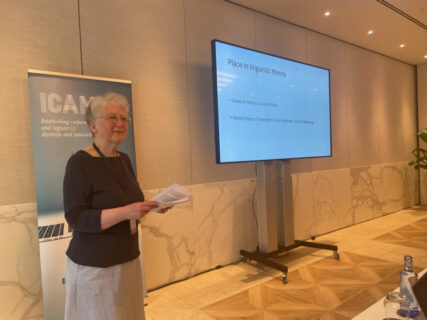Susan Hunston and Sui Xin. Accounting for what is observed in concordance lines

Susan Hunston and Sui Xin: Accounting for What is Observed in Concordance Lines
Author: Alexander Piperski
Published: Posted on 4 November 2024
In this guest post, Susan Hunston, a professor at the University of Birmingham and member of the RC21 advisory board, and Sui Xin from Capital Normal University in Beijing present their talk from the ICAME 45 conference, bridging the gap between concordance reading and linguistic theory.

It is sometimes really frustrating that a single observed entity can have so many different labels. Corpus research using concordance lines has shown that much of English is made up of phrases. For example, a corpus user might notice that it is sometimes really frustrating that… is similar to many other instances. These examples can be formulated as ‘it is [evaluative adjective] that…’. A variable phrase like this can be described as a Unit of Meaning, or as a Construction; it can be analysed as a Frame, or in the terminology of Corpus Pattern Analysis, or of Local Grammar. In the physical sciences, arguably, such divergences of terminology would be ironed out and one of the competing frameworks would emerge as ‘the winner’. In the social sciences, competing frameworks are more likely to co-exist, each with an enthusiastic following, and with overlaps acknowledged but not resolved.
One way of finding a route through the clutter, while acknowledging the validity of all approaches, is to be specific about how the approaches differ. To put it another way: to specify their dimensions of difference. This has the advantage of demonstrating the underlying assumptions of the different models.
We suggest that five such dimensions can be established:
- The starting point for the framework can be cognition (language in the speaker’s mind) or it can be language output (language as appears in a corpus, for example. The cognitive focus is important to Construction Grammar and to FrameNet, whereas the output focus is important to the identification of Units of Meaning and Local Grammar.
- The focus can be on specifying what forms mean or it can be on how meanings are made. Constructions and Units of Meaning specify what forms mean, while FrameNet and Local Grammar specify how meanings are made.
| Mental Focus | Output Focus | |
|---|---|---|
| What forms mean | CONSTRUCTIONS | UNITS OF MEANING |
| How meanings are made | FRAMENET | LOCAL GRAMMAR |
- Similarly, the labelling can label the form or it can label the role. Corpus Pattern Analysis and Units of Meaning label the form of each element (what kind of thing makes up this unit?), whereas FrameNet and Local Grammar label the role the element plays in the whole (what kind of thing does this unit do?).
| Examples | They He |
accepted | that such facilities were expensive that he was dealing with congenital conditions |
|---|---|---|---|
| Corpus Pattern Analysis | Human | That-clause | |
| FrameNet: coming_to_believe | Cognizer | Content |
| Examples | He | accepted | the theory of natural selection |
|---|---|---|---|
| Corpus Pattern Analysis | Human | Proposition | Concept | |
| FrameNet: coming_to_believe | Cognizer | Content |
- The units identified can be context-dependent, relating to a specific situation or rhetorical function, or it can be context-independent, describing the language with relating to specific situations. Framenet and Local Grammar are context-specific whereas Constructions and Units of Meaning are not.
- The units can be part of an ambition to provide a general theory of language, or they can seek to account for only parts of the language. Of the approaches discussed here, only Construction Grammar seeks to account for everything in a language. FrameNet, Local Grammar and Units of Meaning describe parts of the language only.
| General theory | Partial theory | |
|---|---|---|
| Context-specific | FRAMENET LOCAL GRAMMAR |
|
| Non-context-specific | CONSTRUCTIONS | UNITS OF MEANING |
Each of the approaches mentioned combines a different set of dimension choices in formulating its description.
